When it comes to city passes and travel cards, it’s usually fairly easy to figure out whether they would be worth it for you or not. For things like the Paris Pass or London Pass, they have a list of the most popular attractions and how much they cost, right there for you to see. The Swiss Travel Pass, however, is shrouded in mystery, or at least it was until I spent several days tracking down all of the prices and benefits.
A great many of the visitors and commenters on my popular page about where to go in Switzerland on a short visit are wondering whether the Swiss Travel Pass is a good deal. Embarrassingly, I’ve always had to answer that I found the pass too confusing to confidently advise people on. Now that has all changed, after literally days of research.
Note: This article was last updated in February, 2024.
Disclosure: This is a reader-supported website and some of the links are affiliate links where a small commission is paid to help keep this site going, but the cost to visitors is the same. The Swiss Travel Pass seems quite expensive at first, so it felt like it might be hard to get your money’s worth out of it. As it turns out, it’s pretty easy to get good value, and it’ll be a good deal for many visitors.
New in 2024
Prices increased an average of 5.9% from 2023 on the Swiss Travel Passes, but the Half Fare Card remains at CHF120, which is where it’s been for many years. Train fares in the country increased by similar percentages so the value is basically unchanged. There were no other notable changes to service or the included attractions and train routes.
>>>Buy the Swiss Travel Pass online
Where to stay in Interlaken and the Lauterbrunnen Valley
Since most people reading this will be visiting the Interlaken area and I get so many questions about it, I decided to write a detailed guide on which area to stay in while visiting this area.
>>>Where to stay in Interlaken or the Lauterbrunnen Valley in Switzerland
I included many huge photos in that post so readers will be able to get a better idea of what each place looks like and they are worth a look by itself.
>>>Lucerne or Interlaken: Which to visit and how long to stay?
The article just above will help you decide on how long to spend in each of Switzerland’s two best tourist areas.
Are you 100% sure where you want to go in Switzerland? This should help
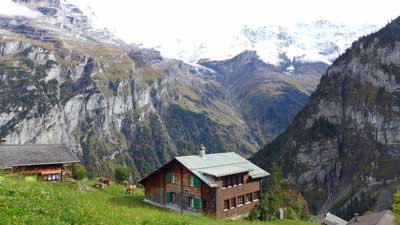
Zurich and Geneva are pleasant but dull. The good news is that Switzerland is packed with amazing sights and none of them are the big cities. If you aren’t 100% locked in yet, please read the article below and I think you’ll enjoy it.
Is the Swiss Travel Pass a good deal? Here's the short version

The bottom line is that the scenery, train journeys, and cable car rides in Switzerland are stunning and not found anywhere else in the world. They are also quite expensive if you pay for them one at a time. So no matter how you visit Switzerland, you are going to be paying quite a bit, or skipping the absolute best things that you’ve come there to see.
With good planning it’s quite easy to get great value out of a Swiss Travel Pass, but it might be a poor choice for those who don’t like to plan ahead. You can easily do a scenic train ride and a cable car in the same day, and still have time to do a scenic hike in the process.
First class or second class? Good news for most people
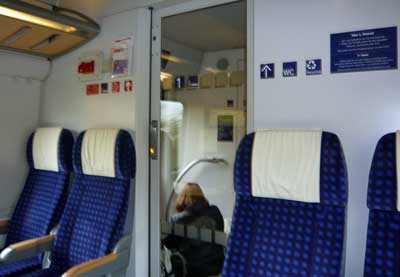
That said, Swiss Trains are literally the nicest in Europe and even the Second Class seats and carriages are nicer and roomier than trains in neighboring countries. The First Class seats are larger and nicer with only 3 across the cabin instead of 4, but honestly Second Class is perfectly comfortable for almost everyone.
Again, First Class on European trains like this is generally popular with business travelers where the company is paying and they need to get work done during the ride, and also senior citizens who don’t want to worry about a carriage full of backpackers. For most of the rest of us, Second Class is more than comfortable enough and the seat width and legroom compare to business-class airline seats. I’m a big and tall guy and I almost always travel in Second because it’s plenty comfortable enough and all the seats arrive at the same time anyway.
The longer you'll be in Switzerland, the better deal a Swiss Travel Pass will be
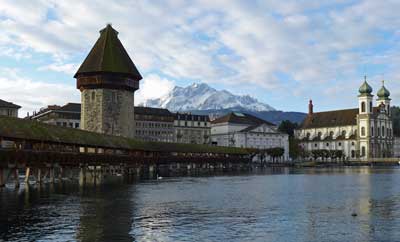
In other words, if you are staying 5 days or fewer, you have to do the math to determine your best option. But if you are spending even 6 or 7 days in Switzerland then the 6-day or 8-day Pass is almost guaranteed to be a great deal and your best choice. Once you have a Swiss Travel Pass you’ll absolutely love the ability to just hop on any train (excellent trains, always on time) and most boats and cable cars without having to worry about the cost. The per-day cost of an 8-day Pass even if you only use 6 of those days is about CHF65, and Switzerland is filled with amazing train rides and boats and cable cars that can get you that much value before noon each day.
Schilthorn (50% discount) and Jungfraujoch (25% discount) are cheaper with a Swiss Travel Pass
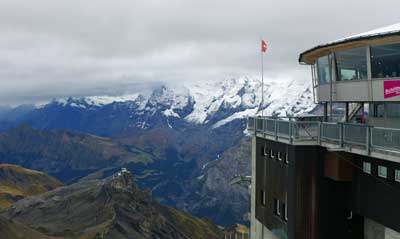
Both of those peak experiences are extraordinary and different from each other. Even so, compared to Jungfraujoch, Schilthorn is also faster and more comfortable on the way up and down. You can enjoy an excellent visit to Schilthorn in 4 hours or so (or a bit longer if you eat at the spinning Piz Gloria restaurant at the top), while a visit to Jungfraujoch requires closer to 6 hours.
NOTE: Schilthorn closes for maintenance for a week or two in late November most years.
Consider the Swiss Half-Fare Card instead
If you AREN’T going to be doing two or more of the long (and expensive) scenic train trips, you will get much better value out of the Swiss Half-Fare Card, which is explained a bit below.
Mt Rigi, near Lucerne, is 100% covered by the Swiss Travel Pass
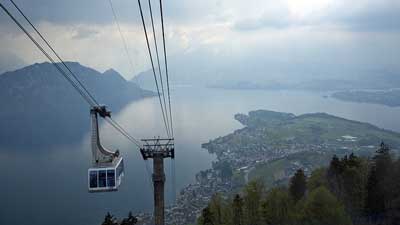
Is a Swiss Travel Pass right for you?
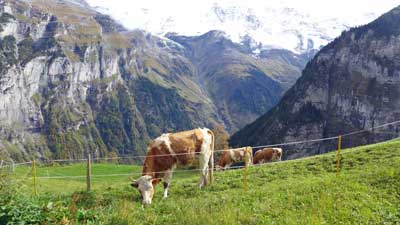
Most people only visit Switzerland for 5 or 6 days at most, so the 3-day and 4-day passes are the ones to focus on. But if you are staying for 8 days or more, those longer passes are almost certainly a great deal for you.
Long story short, if you plan on doing 2 of the more expensive scenic trains and the Jungfraujoch railway or the Schilthorn cable car, then the pass will save you money. Switzerland is expensive, but it’s worth it, and the travel pass can help make it a bit more affordable.
What the Swiss Travel Pass includes
- Free rail travel on normal trains and most scenic trains
- Discounted travel (about 50%) on popular tourist mountain trains
- Discounted travel (about 50%) on popular tourist cable cars
- Free travel on public transport in 75 towns and cities
- Free entry to around 500 museums in Switzerland
The Swiss Travel Pass covers the fare on the most popular scenic and panoramic trains. You can choose a normal seat in a regular carriage for no additional cost, but there is a supplement of CHF8 to CHF49 for a reserved seat in one of the special panorama carriages on these routes.
Prices of the 2024 Swiss Travel Pass
1st Class
- Adult 3-day Pass: CHF389
- Youth (4 to 25) 3-day Pass: 274
- Adult 4-day Pass: 469
- Youth (4 to 25) 4-day Pass: 330
- Adult 6-day Pass: 602
- Youth (4 to 25) 6-day Pass: 424
- Adult 8-day Pass: 655
- Youth (4 to 25) 8-day Pass: 469
- Adult 15-day Pass: 723
- Youth (4 to 25) 15-day Pass: 512
2nd Class
- Adult 3-day Pass: CHF244
- Youth (4 to 25) 3-day Pass: 172
- Adult 4-day Pass: 295
- Youth (16 to 25) 4-day Pass: 209
- Adult 6-day Pass: 379
- Youth (16 to 25) 6-day Pass: 268
- Adult 8-day Pass: 419
- Youth (16 to 25) 8-day Pass: 297
- Adult 15-day Pass: 459
- Youth (16 to 25) 15-day Pass: 328
Swiss Travel Pass Flex
This version costs a bit more, but you don’t have to use the travel days consecutively. It’s a great option for anyone who won’t be taking longer train rides each day.
- Adult 3 Flex days in 1 month (1st Class): CHF445
- Adult 3 Flex days in 1 month (2nd Class): 279
- Adult 4 Flex days in 1 month (1st Class): 539
- Adult 4 Flex days in 1 month (2nd Class): 339
- Adult 6 Flex days in 1 month (1st Class): 644
- Adult 6 Flex days in 1 month (2nd Class): 405
- Adult 8 Flex days in 1 month (1st Class): 697
- Adult 8 Flex days in 1 month (2nd Class): 439
- Adult 15 Flex days in 1 month (1st Class): 755
- Adult 15 Flex days in 1 month (2nd Class): 472
Where to buy the Swiss Travel Pass
The Swiss Half-Fare Card – A better option for many visitors
Far less confusing than the Swiss Travel Pass, you can instead get a Swiss Half-Fare Card, and it will be a better deal for many travelers. The price is lower and it’s much easier to do the math, and the discounts are greater on some things as well.
- Swiss Half-Fare Card for 30 days: Adults – CHF120 or US$129
What you get:
Those who buy the Swiss Half-Fare Card will get 50% discount on all trains, buses, and boats in Switzerland for up to 30 days, as well as 50% off all public transportation in 75 cities and towns.
>>>Buy the Swiss Half-Fare Card
Why the Half-Fare Card is a better deal for many
While the Swiss Travel Pass is a great deal for those doing many of the expensive scenic journeys and mountain sights within a few days, it’s not good value for those who are doing fewer of the expensive trips and/or those who are staying longer. Also, the Swiss Travel Pass only provides a 25% discount on the amazing Jungfraujoch Railway, which costs between CHF120 and CHF224 return depending on your starting point, while the Half-Fare Card provides a 50% discount.
The math is simple as well. You can just add up the cost of the trains, boats, and buses you’ll be taking while in Switzerland, and if the total is more than CHF240 or so, the Half-Fare Card will save you money.
Example itinerary:
- Zurich to Interlaken train (2nd Class): CHF50
- Schilthorn Cable Car: CHF112
- Jungfraujoch railway from Interlaken: CHF205
- Interlaken to Lucerne train (2nd Class): CHF33
- Mt Rigi roundtrip from Lucerne: CHF84
- Engelberg (near Lucerne) to Mt. Titlis Cable Car: CHF92
- Lucerne to Zurich train (2nd Class): CHF25
Total per person: CHF601
Total with Half-Fare Card (including price of card): CHF420.50
It would be tough to do all of those things in 4 days, although it is possible. If you bought a 4-day Swiss Travel Pass here is how it adds up:
4-Day Swiss Travel Pass: CHF259
Supplements for Schilthorn, Jungfraujoch, and Mt. Titlis: CHF203.25
Total cost: CHF462.25
Bottom line on the Swiss Half-Fare Card
Since the Half-Fare Card lasts 30 days and provides a larger discount on Jungfraujoch, it is better value for visitors who want to include that scenic top-of-Europe rail journey on their trip. The discounts also add up more quickly on Schilthorn and Mt. Titlis trips, just to name two examples, and you don’t have to take many longer rail journeys to get value out of the Half-Fare Card.
Swiss Saver Day Pass (A one-day unlimited travel pass)
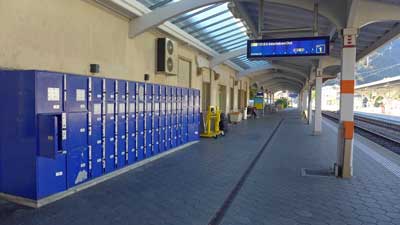
If you buy the Saver Day Pass at least 21 days in advance (and up to 60 days in advance) the 2023 cost is:
- 2nd Class (with Half Fare Card): CHF29
- 1st Class (with Half Fare Card): CHF82
- 2nd Class (with no Half Fare Card): CHF52
- 1st Class (with no Half Fare Card): CHF97
Once you research the normal cost of Swiss train fares you’ll see that the above prices are a very good deal for anyone riding more than 150 kilometers or so in a day. If you are just going, for example, from Zurich to Lucerne or Interlaken on a day, it’ll be cheaper to just buy that ticket individually. But if you are going from Geneva or Montreux to Interlaken or Lucerne then the Saver Day Pass will be much cheaper. Better still, you can use a Saver Day Pass to go from Interlaken to Geneva and back on the same day on the Goldenpass line and returning on the faster train through Bern, and it will still all be included for free.
If you don’t buy a Saver Day Pass at least 14 days in advance it’s more expensive, and if you only buy 1 to 3 days in advance it’s VERY expensive, so the key is to buy early. This is all confusing, but the Saver Day Pass should be a great option for many people only in Switzerland for one to three days.
Popular Swiss panorama scenic trains
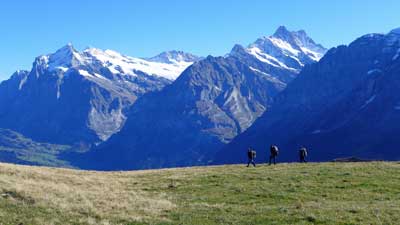
- Glacier Express
- Route: Zermatt to St. Moritz
- Train type: Panorama
- Journey time: 8 hours 3 minutes
- Distance: 291km
- 1st Class fare: CHF272
- 2nd Class fare: CHF159
- Compulsory seat reservation fee: CHF44 or 49
- Supplement for Swiss Pass holders: 13 to 33 for panorama carriage
- Bernina Express
- Route: Chur to Tirano and Lugano
- Train type: Panorama and bus
- Journey time: 4 hours 13 minutes and 3 hours 10 minutes
- Distance: 148km and 90km
- 1st Class fare: CHF113
- 2nd Class fare: CHF66
- Compulsory seat reservation fee: CHF32
- Supplement for Swiss Pass holders: 10 to 14 for panorama carriage
- GoldenPass Line
- Route: Lucerne to Montreaux
- Train type: Panorama
- Journey time: 5 hours 8 minutes
- Distance: 191 km
- Prestige Class fare: CHF131
- 1st Class fare: CHF96
- 2nd Class fare: CHF56
- Supplement for Swiss Pass holders: 8 to 15 for panorama carriage
- Gotthard Panorama Express (formerly Wilhelm Tell Express)
- Route: Lugano or Locarno to Lucerne
- Train type: Panorama and boat
- Journey time: 5 hours 21 minutes
- Distance: 182 km
- 1st Class fare: CHF164
- 2nd Class fare: CHF135
- Supplement for Swiss Pass holders: 39 to 49 for panorama carriage
- Swiss Chocolate Train
- Route: Montreux to Broc round trip
- Train type: Panorama or First Class
- Journey time: X hours X minutes
- Distance: 82 km
- 1st Class fare: CHF99
- 2nd Class fare: 89
- Supplement for Swiss Pass holders: 39
Popular Swiss scenic and theme trains
The scenic trains below are also extremely popular as sightseeing journeys rather than just as transportation, but can be used as both.
- Jungfraujoch round trip
- Route: Interlaken to Jungfraujoch
- Train type: special mountain train
- Journey time: 4 hours 41 minutes, round trip, plus time on top
- Distance: 73 km
- 1st Class fare: N/A
- 2nd Class fare: CHF224
- Supplement for Swiss Pass holders: 147 (so, a saving of CHF77)
- Gornergrat Railway
- Route: Gornergrat Railway
- Train type: Cog railway
- Journey time: 44 minutes return
- Distance: 10 km
- 1st Class fare: N/A
- 2nd Class fare: CHF90
- Supplement for Swiss Pass holders: 45
- Rigi round trip
- Route: Lucerne to Rigi
- Train type: Cog railway
- Journey time: 3 hours 25 minutes, plus time at the top
- Distance: 58 km
- 2nd Class fare: CHF78
- Supplement for Swiss Pass holders: None (this one is free with the pass)
- Mt Rigi Excursion (one-way and walk down)
- Route: Lucerne to Mt Rigi
- Train type: cogwheel train and/or cable car
- Journey time: 45 minutes up
- 1st Class fare: N/A
- 2nd Class fare: 49
- Supplement for Swiss Pass holders: 0
- Lotschberg Mountain Route and Centrovalli
- Route: Bern to Locarno
- Train type: Narrow gauge
- Journey time: 4 hours 40 minutes
- Distance: 212 km
- 1st Class fare: CHF158
- 2nd Class fare: CHF90
- Supplement for Swiss Pass holders: 5
- Jura round trip (Watchmaking Tour)
- Route: Neuchatel through Jura
- Train type: Regular
- Journey time: 3 hours 0 minutes
- Distance: 143 km
- 1st Class fare: CHF168
- 2nd Class fare: CHF108
- Supplement for Swiss Pass holders: 0
- Pre-Alpine Express
- Route: St. Gallen to Lucerne
- Train type: Regular
- Journey time: 2 hours 15 minutes
- Distance: 146 km
- 1st Class fare: CHF83
- 2nd Class fare: CHF47
- Supplement for Swiss Pass holders: 0
- Jura Foot Line
- Route: Basel to Geneva
- Train type: Regular
- Journey time: 2 hours 40 minutes
- Distance: 248 km
- 1st Class fare: CHF132
- 2nd Class fare: CHF75
- Supplement for Swiss Pass holders: 0
Popular Switzerland cable car rides
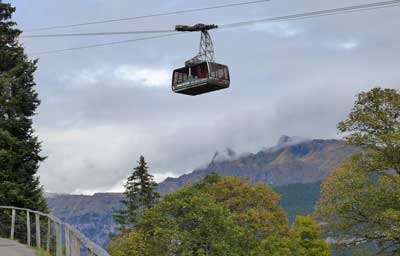
- Schilthorn
- Route: Stechelberg (Lauterbrunnen) to Schilthorn
- Train type: cable car
- Journey time: 1 hour
- 2nd Class fare: CHF108
- Supplement for Swiss Pass holders: 54
- Engelberg to Mt. Titlis cable car
- Route: Engelberg to Mt. Titlis
- Train type: cable car
- 2nd Class fare: CHF96
- Supplement for Swiss Pass holders: 46
The Swiss Travel Pass also includes free museum admission, but…
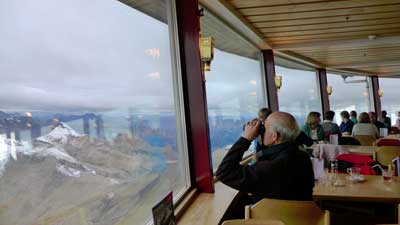
The problem is that the museums are only free on valid travel days, and almost no one would visit more than one or two museums with a Swiss Travel Pass. The trains and cable cars are so expensive that the pass gives very good value to cover those, so you don’t want to waste precious sightseeing time walking through a museum that only costs CHF10 anyway.
In other words, calculate the value of a Swiss Travel Pass on the travel savings only, and if you visit a museum here or there, then great. Most people are better off trying to squeeze in an additional train ride each day, and ignoring the museums. Switzerland is all about the outdoor scenery. As nice as the museums may be, they are not why you are there.
The pass includes free public transport in most Swiss cities
Similar to the free museum part of the offer, it’s best to ignore or minimize the value of free public transportation. It could be helpful in Zurich, but in most other Swiss tourist towns you won’t need much public transport. In fact, in Interlaken, each hotel or hostel guest automatically gets a card for free public transportation within the town (including between the two train stations).
So you might use a ride or two each day on public transport, but that won’t add up to much in terms of value of your Swiss Travel Pass.

Hi Roger,
You’ve helped me before. Thanks. My trip is March 2-27th.
For Interlaken area:
I’m having trouble deciding upon logical 1.5 day itinerary. I see many opinions online. (some pasted in below)
For my needs—(arrive Interlaken Ost 2pm or later on Fri. March 16th. Leave on train to Spiez around 7am on Monday March 18th)
Solo traveler/backpack and one stuffed purse, and budget being key. Lugging this backpack and purse around would be doable for short stretches combined with train or other transport, but not for long hiking.
I will try to save money in the beginning half of my trip. If I do so, I might then splurge on both Schlithorn and Jungfraujoch. If not, I may have to choose. I know I may have to choose anyway depending on weather.
I see lots of availability in hostels (affordable!) in Interlaken and in Lauterbrunnen as well as some affordable B&Bs in Wengen. Murren would be a splurge but I’d do it, if it made sense logically in terms of getting from point A to point B.
I’ve bought my train ticket from Paris to Basel. Now, I’m debating on the saver fare on the connection from Basel to Interlaken Ost (what if I miss that train even with built in padding of extra time?) And debating the Swiss Half Fare card which will help defray the cost of that ride as well as the Schilthorn and Jungfrau. I know I can wait to buy that leg of train fare until it gets closer, forfeiting the chance of a Saver Fare, likely.
(I’ve bought my train ticket to Milan from Spiez as well on Monday March 18th. (8:30am or so)
I’m assuming it would be best to stay in a hostel within walking distance to Interlaken Ost my last night.
What is a logical base city for night one, assuming my arrival time in afternoon on day one, and doing Schilthorn if weather permits?
On the lifts, is it one trip up and one trip all the way down, once paid, with option to walk around connecting villages? Here is what I see on the app.
https://schilthorn.ch/cmsfiles/tarif-flyer_2018.pdf
When/where would be a logical place to stay, without backtracking (at a cost) to retrieve luggage, even after check out? Knowing that plans may be affected by weather.
Should I stay in either Wengen, Lautenbrunnen or Murren on night one, then check out and take backpack all the way down to Interlaken to Hostel, check in, leave bags, and then start day 2 fresh from there, bag free?
Or is there a way to take bags with me after check out from Lodging location of night one, then proceed to say, the Jungfrau and leave bags in a locker? Then finish that and not go to Interlaken Hostel until later that night to check in.
Thanks in advance,
Laura
Recommendations I’ve seen online:
If you want to go up to the Schilithorn and spend a few days in that region there are alternatives. IMO Lauterbrunnen, which is in a valley, is the best location to move between the Schilthorn/Muerren side and Wengen/ Jungfrau which is on the opposite side.
In Lauterbrunnen the valleyhostel.ch offers shared dorms, double rooms, and individual rooms inexpensively and one can cook food to save money if you are on a budget. This is as inexpensive as you will get in this region and it is in an excellent location only a couple of minute walk from the train station and the Cable Car from which you can begin your ascent to Gruetschalp. There you take a shuttle train to Muerren and then walk throught this tiny town and view the gorgeous panoramic views of the Eiger, Moench, and Jungfrau Mts. THen take the Schilthorn Bahn up to Piza Gloria. On the way down you could take the Schilthorn Bahn to Stechelberg and then the bus back to Lauterbrunnen or you can walk the valley back to Lauterbrunnen.
____________________________________________
Going to anywhere in the Jungfrau region from Luzern and back in one day is not advisable – you will spend most of your day on trains.
I would go from Zürich to Mürren and stay there. Get your hotel booked in advance as you will be there in Ski season. OR make your base in Interlaken – not the best place in Switzerland but there is cheap accommodation to be had there – and then go to Mürren and the Schilthorn for the day.
Lauterbrunnen is OK but is very small with little choice in the way of hotels and is on the valley floor with high cliffs on each side. Mürren is high up (1800m) and has lovely open views over to the Jungfrau massif. Much better choice even if more expensive.
_________________________________
. Re: Is Wengen the best place to stay as a base in switzerland
May 27, 2015, 12:45 AM
Sounds like it starts in Lauterbrunnen. The cog railway would be the 15 minute trip up to Wengen where you catch the gondola to Männlichen, then back down to Lauterbrunnen and up the other side of the valley to Murren and cable car up to Schilthorn.
Take the cable car back down, this time all the way to Stechelberg in the floor of the valley, and take in Trummelbach falls on the way back to Lauterbrunnen.
Absolutely no reason why you can’t do all or part of this by yourself. These destinations are very close together, and will give you a great overview of the Oberland.
. . ——————————
Logistically, for a short visit, Lauterbrunnen IMO is probably The best base to stay, if you want to travel between the various mountains which it separates. That is not to say that Lauterbrunnen itself is not an inspiring place to stay as well! The narrow valley’s centerpiece is a gorgeous waterfalls which Goethe made famous in his poem, “Gesang der Geister über den Wassern (Song of the Spirits Over the Waters). One consistently recommended Hotel in Town in thehttp://www.staubbach.com/
Or if you are budget minded that is a great hostel http://www.valleyhostel.com
They also have private rooms but fills up quickly so if interested contact them directly ASAP. For July and August you want to be making reservations now. I know, for example, many places in Lauterbrunnen are completely booked already for most of July.
Mürren, which again, is on the opposite side of Wengen, is known as the “Dorf auf der Mauer” (Village on the Wall). It resides on the end of a plateau above the Lauterbrunnen valley (on the same side as the Staubach Falls). You reach it by cable car from Lauterbrunnen to Gruetschalp, then a short equisite train ride to Muerren. The town is quite small and heidiesk! You have incredibly stunning views of Eiger, Moench, and Jungfrau Mts. I assure you the modifiers are not Hyperbole! Stop at one of the hotels on the left hand side with a Terrace to sit at (Edelweiss is one). Have a glass of wine or a beverage and drink in the beauty of the views! Then move on to The Ride up to the Schilthorn. On the way down stay on the Cable Car all the way down to Stechelberg. You will then be on the other side of the Lauterbrunnen in Stechelberg. From there you can walk back (abt 1 hr) to Lauterbrunnen or you can catch the post bus back to Lauterbrunnen or get off at Truemmelback Falls.
HI,
My first choice is always Lauterbrunnen because you are right at the transportation options for going up to either the Murren/Schilthorn side, or the Wengen/Eiger side. Lauterbrunnen does have less room availability. Wengen has more volume. If you are sole focusing on the Eiger walk…then Wengen would be a better base. There is nothing wrong with staying in Grindelwald, but it is more difficult to get to the Murren/Schilthorn side. Plus, I find Grindelwald not particulary picturesque as I find both Murren and Wengen.
If the weather is nice, I would stay in the mts. and not visit Thun.,,, until I was finished with the region. Thun is easily reached from Interlaken. Why waste time, going back and forth when you can do it at the end? Also you will save money-even with half fare pass!
Have a great hike!
Laura,
I’ll try to answer the questions in order…
I’m not sure what happens to Saver tickets if you miss them, but my guess is that you can use them on the next train if the first one arrived late. Swiss trains are notoriously punctual, but a train from Paris could be late. That said, the high-speed intercity trains like that do tend to run on time.
The Half Fare Card will pay for itself pretty quickly so I highly recommend it. As you mention, Schilthorn or Jungfraujoch nearly pay for the HFC alone, and those little cable cars and boat rides also add up.
You could stay near either train station on your last night, as all trains stop in both stations and Spiez is actually closer to the West station. There are more restaurants and such near the West station as well. And again, the trains are remarkably punctual, so you won’t have to worry.
If you could stay in Gimmelwald (at the Mountain Hostel) or in Murren on your Schilthorn day, that would be ideal. The views from both villages are absolutely stunning. The cable car up to Schilthorn runs until about 10:30pm for the bottom few legs, and it starts early, so you can always get up and down. From the Lauterbrunnen train station you walk outside and you’ll see a bus waiting for the train passengers. It goes to Stechelberg, which is the bottom of the cable car. Off the bus and in the queue for the cable car you go. Once in motion the cable car takes 5 minutes up to Gimmelwald. Then you walk across the platform into the waiting cable car that goes 5 more minutes up to Murren. Then you get off that one and walk just a bit onto another one that takes you about 10 minutes up the mountain into another village. I think from there the next cable car takes you all the way up to the Schilthorn Observation Deck.
If you stayed in Gimmelwald or Murren you could leave your bag at the hostel and come back for it on the way down. The cable cars go every 30 minutes so you’d have to wait for the next one, but it’s no problem doing the journey over the course of the day. In other words, you don’t have to go straight up and straight back down. I highly recommend people get off in Murren and walk around a bit on their way down, and then walk 15 minutes down the hill to Gimmelwald to take the final leg down.
The cable cars are huge by the way, so you could take your bag with you. They have room for about 60 people standing up, and there is usually far fewer than that. You’ll often ride up and down with locals who are transporting wood or groceries or whatever else, so a backpack is no problem. There are also luggage lockers at the Interlaken train stations, and probably in Lauterbrunnen as well. As always, let me know if you have any other specific questions. I’m sure you will love this trip. -Roger
Thank you Roger. Your response does shed more light.
I was trying to estimate the total transportation cost for our trip to determine the type of Pass (Swiss Pass or Half Fare Pass) that would be appropriate for us. In doing so, I came across a discrepancy. Your website on Lucern indicates the fare from Lucerne to Zurich as USD 33.45 whereas the SBB indicates it as CHF13 for Zurich and CHF15 for Zurich Airport. USD and CHF being almost equal, not sure if it was a typo in your website.
I wanted to share the itinerary I planned and would be glad to have your comments.
April 09 > Reach Zurich airport at 06.15 and take a train to St Moritz (what would be better – spending first part of the day at Zurich and then proceed to St Motitz or proceed to St Motitz rightaway and spend the second half of the day at St Motitz ?)
April 10 > Take Glacier Express from St Moritz to Zermatt (we were prepared to stay at Zermatt if we could view Matterhorn which probably will not be possible as the train would reach Zermatt at about 5pm). Hence we will take another train from Zermatt to Interlaken the same evening and spend the night at Interlaken.
April 11 > Explore Interlaken area (not sure if we can do both Jungfraujoch as well as Schilthorn) including the 3 vilages over it. We will explore if we can get suitable accommodation in one of the villages. if not, will stay at Interlaken.
April 12 > Spend the morning at Interlaken and proceed to Lucerne in the afternoon. Depending on the time, we will try to take the Interlaken – Lucerne Panoramic Express. Explore Lucerne in the evening.
April 13 > Explore Lucerne area including Pilatus and Titlis (possibly there will be no time to visit Bern)
April 14 > Take an early morning train from Lucerne to Zurich airport as our flight from Zurich leaves at 09.35
Do you think this is doable / feasible or some adjustments can make this 5 day trip better ?
Regards,
Subrata
Roger,
Thanks again. I am getting very confused when I am browsing online to plan my trip. On SBB website I was trying to specifically check the schedules of the panoramic trains for different times, but all I could see was a list of trains between the two stations. May be I am missing something ! Is there a way to specifically search the scenic train routes with time table and fares ? Can I use a second class Swiss Pass or Half Fare Pass to make a reservation in a panoramic coach on one of the scenic routes ? Do I purchase the Pass first and then make seat reservation online ?
I always plan my trips and make my bookings online. But I am not sure why I am getting stuck planning this trip.
Can you help please ?
Subrata
Subrata,
Once you get to Switzerland you’ll be amazed at how nice and efficient the train system works. But until then you’ve correctly discovered that the website is very confusing and hard to find what you need. Strangely enough, the scenic train lines with names all have their own websites, or at least websites where additional information can be found. For example, here is the timetable for the GoldenPass line. On that schedule you need to look for the departures that have one or two asterisks, as those are two different kinds of panoramic trains. If you are looking for a different line you can just Google the name of it and add ‘schedule’ and you should be able to find it. Once you find which departures have the panoramic trains you can look for the word “book” on those websites. They all offer official tickets at the same prices, and I believe they are all run by government organizations that promote those lines. You might also be able to book those special carriages on the SBB website if you choose the right one. I think it’s somewhere towards the end of the booking process where it asks if you want any extras. I work with this all the time and it’s still confusing to me, so don’t feel bad, but you should be able to get what you want.
If you have purchased a Swiss Travel Pass you can actually just board any “regular” train for free, as long as you have validated the Pass before you climb aboard. And for the panoramic trains you can simply make a seat reservation on those websites I mentioned, and that will cover the extra fee. Once on board you just show your Pass for the trip itself and show the seat reservation receipt for the seat. You can (and should) buy your Swiss Travel Pass from home and print it out before you leave with no cost for delivery, and that way you are ready once you get there.
To buy tickets with the Half Fare Card, you just search the normal SBB.ch site and find the ticket you want. On the next screen it will have a spot for a “discount card” and there you just click on it and pull it down to Half Fare Card, which will then cut the price of the ticket in half. You can actually buy half-fare tickets at any time and then buy your Half Fare Card later if you like. The only trick is that when you get on board the train and the ticket person comes by to look at your ticket, you need to show them BOTH the ticket receipt and the Half Fare Card. You might as well buy the Half Fare Card online from home as well, to make sure that it’s all sorted out before you get there.
Sorry it’s so confusing and let me know if you have other questions. -Roger
Roger,
I cannot thank you enough for your prompt response. I have a specific question here – if I buy a Swiss Travel Pass, will that cover the full price of all kinds of transportation (local trains, cable cars and scenic trains including panoramic trains) ? I believe the Half Fare Card does not cover any percentage of the scenic train ride fares. This is my impression after browsing SBB website. However, you can confirm.
I live in Canada and see snow all over for six months a year. My interest is to see the green pasture and rolling hills not covered in snow. What would be the right time for that except the crowded summer months ? I can re-plan my trip at that time instead of second week of April if it is not the right time.
Regards,
Subrata
Subrata,
The Swiss Travel Pass is indeed confusing, which is why the article above is so long. The pass itself covers all normal city to city trains and most long distance buses and many boat rides and most cable car rides that are part of the normal transportation infrastructure. As an example, it covers the first two legs from Stechelberg to Gimmelwald and then Gimmelwald to Murren, on your way up to Schilthorn, because those are used as normal transportation by locals. The rest of the ride up to Schilthorn is considered a tourist attraction and so the Swiss Travel Pass only gets you a 50% discount.
As for the scenic trains, the article above shows what is covered by the pass and how much the supplement is for the specific panoramic carriages. The Half Fare Card will cover 50% of the train ride itself, but you’d still have to pay the small supplement for the panoramic carriages. All of the “scenic” train routes with names are also normal trains that take people from one city to another, so the Half Fare Card covers half of that price. On the other hand, Jungfraujoch and the one up to Zermatt are NOT normal public trains so the Swiss Travel Pass only gets you a discount on those (25% off in the case of Jungfraujoch). As we have discussed, it’s complicated. In my experience the Half Fare Card is the best choice for most visitors who will be in Switzerland for at least 2 or 3 days doing sightseeing. But for those who plan on taking at least two of the longer train rides, the savings of the Swiss Travel Pass can be even greater.
Regarding snow in Switzerland, the highest peaks have snow all year, but the valleys (which is most of Switzerland) tend to only have snow for a short time after a snowfall. In other words, by the time March rolls around you’d be unlucky to see snow in the valleys and towns, and by April you are pretty much guaranteed of seeing nothing but green. Of course, weather can be unpredictable, so there are no real guarantees. It’s also worth noting that the summer months are also the rainy months in the Alps, so spring and autumn have many advantages. I think the second week in April should be great for what you have in mind. Have a great trip. -Roger
Hi Roger,
It’s an absolutely great place to obtain very useful information. We two will be spending about 3-4 days in Switzerland during the second week of April. We would prefer to travel on our own, not using any conducted tour like Viator. Our preference is to visit a charming Swiss village, take a scenic panoramic train ride, and have the best views of the Swiss Alps. We wanted to see Bern, but understand this will not be possible in this short time.
Can you please advise if it is possible to visit all the places ourselves just using public transportation (without using a conducted tour) and if Swiss Travel Pass or Half Fare Card will help – ? Will you kindly suggest an itinerary so that we can plan the best possible trip we can have in this short time ?
Thank you,
Subrata
Subrata,
I’m glad you find this useful. Yes, you can and absolutely should see Switzerland on your own rather than on an organized tour. First off you might have a scan of my main article on where to go in Switzerland on a short visit. The short version is that you should focus on the Interlaken area for the most dramatic views, and you might even have time for a day or so in the Lucerne area. It’s very easy to get around on public transportation, and Switzerland has probably the best train system in the world. Just about everyone you encounter as a tourist will speak pretty fluent English, and you don’t even have to ask before you begin the conversation.
One important thing to consider about the mountain peaks in Switzerland is that they can be cloudy or foggy on any day of the year, and often they are clear in the morning and foggy in the afternoon. When it’s foggy up top there is no point in going up the famous peaks such as Jungfraujoch or Schilthorn. All of the main sights have webcams and detailed forecasts, so you usually know a few hours ahead of time how things are looking. If it’s foggy (as in, the clouds are the same altitude as the peaks) up top, you can take a one-hour train ride to Bern and have a lovely time looking around the city for a few hours.
You’ll see in that other article that Gimmelwald is an amazing and tiny village to stay in if you can, while Murren is larger and just above it on the same mountain. Lauterbrunnen is a lovely village below those two, and Wengen is another very scenic village a short train ride from Lauterbrunnen.
As for scenic train rides, pretty much every train ride in Switzerland is very scenic, at least once you get outside of Zurich. So my recommendation is to go to the places you want to see, and enjoy the excellent scenery along the way. You could take one of the scenic train rides with names such as the GoldenPass, but I would just take trains between the places you want to see. The Half Fare Card is almost guaranteed to be your best bet for saving money, unless you plan on taking at least two longer train rides in which case a Swiss Travel Pass might even be better. As always, let me know if you have any other questions. -Roger
Hello roger.
You are doing an amazin job. Thank you..
Me and my wife are planning to travel to switzerland and this is our plan…
Reach on 7th feb zurich airport. Stay in zurich on 7th and 8th to visit the rhine falls and the local zurich scenery.
Take train to lucern on the 9th. And whilst there do mt rigi pilatus and mt titlus.. return to zurich hb on 12 to board our train to paris..
Is the schilthorn worth the visit ? And how to do that ?
Also based on above itenary should we get the swiss rail pass or the half fare pass ?
Thanks a lot
Aamir,
Thank you for the kind words. You might have a quick scan of my article on where to stay in Switzerland on a short trip. It sounds like you may have a similar travel style to me, where I almost always start by visiting the largest city in a new country for a few days to get my bearings. The thing about Switzerland is that the scenery is absolutely amazing, and Zurich itself is kind of dull and very expensive. If you have specific things you want to visit in Zurich then by all means spend a couple days there. But if you really want to see the best that Switzerland has to offer and NOT spend an absolute fortune, I would consider just going straight from Zurich Airport to Lucerne, and spending that extra day in the Interlaken area. Interlaken has the most dramatic sights, which are Jungfraujoch and Schilthorn, and both of them are definitely worth it if you have the time. I think the Half Fare Card would be best for you since you aren’t planning on doing at least two long train trips. I give instructions on going to Schilthorn on that other article. Let me know if you have any other questions. -Roger
We are a family of 4 (my mother 67, my son 13 and two of us). We are coming to Switzerland for first time in June. We will be arriving from Venice on 9th and taking our flight from Zurich on 14th morning. Please suggest the best itinerary considering we would like to see the maximum possible including the scenic trains with the Swiss Pass.
Kautilya,
I really don’t like to write out itineraries for people, mostly because tastes and budgets are different for everyone. I have most of my advice for what to do in my main article on where to go in Switzerland. If you have 5 days to fill I would recommend 3 days in the Interlaken area and two days in Lucerne. You’ll be able to go directly from Lucerne to the Zurich Airport in about an hour and the trains start by 05:00 so most likely you could easily get there.
You may not want to buy the Swiss Travel Pass depending on what you want to do. All of the famous ones are listed in the article above, and if you are keen on train travel I would choose 2 or so of the ones that sound most interesting to you. Let me know if you have any questions. -Roger
Thanks Roger. I notice that i did the info wrong.
05-Jul Land in Zurich and go straight to Bern (Day in Bern)
06-Jul Bern to Interlaken – Day in Interlaken
07-Jul Murren to Schilthorn (Thrill Walk – Alp)
08-Jul Lucerne to Zurich
09-Jul Zurich to Return in the Morning
Murren to Schilthorn planning on getting the cable car. I do not think my parents can manage the hike 🙂
ard
As for Zurich I am not that fussed. With my itinerary it would be great if you are able to suggest places for us to visit.
If you could go through my plan and let me know if Half Fare Card is the best option.
Thank you again.
Ash
Ash,
When visiting Bern it’s really the historic town center that you want to see, and they have a free (tips-based) walking tour that I can recommend. The setting of Interlaken is really lovely, but the town itself won’t take more than 2 or 3 hours at most to explore. If you research things to do in Interlaken you’ll find many great choices to fill several days if you had them.
In Lucerne I mention the most popular choices in my article about where to go in Switzerland that you may have seen. Unlike Interlaken, the town of Lucerne is much larger and has more obvious things to do. The boat tours leaving from across from the train station are wonderful, and just walking across the Chapel Bridge is worth some time.
I definitely think the Half Fare Card looks like the best value for your trip compared to the Swiss Travel Pass. The train rides you are planning don’t look like they’ll add up to enough to justify the Swiss Travel Pass. Bon voyage. -Roger
Hi Roger,
I hope you will be able to help with my 5 day itinerary. I am taking my family (parents & brother) on a trip to Switzerland from 5 to 9 July. the following is what I have planned:
05-Jul Land in Zurich and go straight to Bern (Day in Bern)
06-Jul Bern to Interlaken – Day in Interlaken – stay 3 nights in Interlaken
07-Jul Murren to Schilthorn (Thrill Walk)
08-Jul Lucerne
09-Jul Zurich
10-Jul Flight back to the UK at 10am
Please could you let me know if this is ok. I also believe the Swiss 4 day pass will be ideal for us, but please could you let me know otherwise.
Thanks
Ash
Ash,
This looks quite good. I assume you realize how steep the hike from Murren to Schilthorn is, and that you must be in good shape. 🙂
Unless you really want to see Zurich and pay the high Zurich hotel prices, I would recommend staying in Lucerne on that last night. You can get from the Lucerne train station to the Zurich Airport train station in a bit over an hour, and the first train of the day runs at 04:55. Also, Swiss trains are famously punctual so you don’t have to worry. To get from a hotel in Zurich to the Zurich Airport would take almost as long, unless your hotel was next to the train station itself.
The Swiss Travel Pass is best for those doing at least two longer scenic rail trips, and it doesn’t look like you have any of those scheduled. You might be better off with the Half Fare Card, unless you plan on doing at least a few more rail trips that you haven’t mentioned. Aside from that I think it looks great. Let me know if you have any other questions. -Roger
Hi Roger,
We are planning to visit Switzerland in mid-March 2018 between 19th to 24th. I want to be sure that this is a good time to visit Switzerland. Will we get to see greenery and the breathtaking views mentioned on your website or will it be cloudy and snowy most of the time?
Your recommendation will be highly appreciated.
Thank You,
Sue
Sue,
Switzerland is an unusual destination from a weather and seasons standpoint. Long story short, it’s a year-round destination and most likely you’ll have decent weather and a wonderful time. The grass in the valleys and lower elevations is mostly green all year round, and by late March you probably won’t have snow at the low elevations. The good news is that the mountains will still be largely snowy and they look even more beautiful that way. The summer months are also the rainy months in the Alps, although the rain itself rarely causes much of a problem because it’s usually light. The highest mountain peaks are snowy all year long, and the lower elevations look nice with or without snow.
The other issue is the clouds and weather, which can roll in on any day of the year. At the highest peaks such as Jungfrau and Schilthorn you often get clear mornings and then foggy afternoons, although sometimes the other way around, and that can happen any day of the year. The fog is basically like being in the clouds, and when it’s like that there is no point in going to the peaks. But it’s rare that it’s that way all day or for days in a row, although that can happen. In other words, it’s a bit of a crap shoot any day of the year. Still, you’d have to be very unlucky to go and have poor visibility for most or all of a 5-day visit. The trick is to keep a close eye on the weather at the peaks and then go up when you know it’s looking fairly clear. When it’s foggy up there you can wander around the city or do hikes at lower elevations and it’s always beautiful. I’m not sure this answer builds much confidence, and a visit to the Alps is always a bit of a gamble, but it’s rare when any trip is ruined by weather as long as you are paying attention to the forecast and planning your activities around it. -Roger